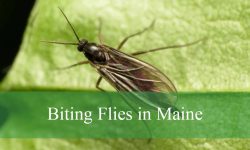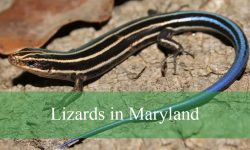Hummingbirds are among the most fascinating bird species, known for their iridescent feathers, rapid wingbeats, and hovering abilities. With over 300 species worldwide, North America is home to a remarkable variety of these tiny birds. In the United States alone, you can find several types of hummingbirds, each with unique colors, markings, and behaviors. From the vibrant Ruby-throated Hummingbird to the striking Anna’s Hummingbird, these aerial acrobats play a vital role in pollination.
In this guide, we’ll explore 30 types of hummingbirds found in North America, helping you identify them through pictures and key characteristics.
Different Types of Hummingbirds
Ruby-throated Hummingbird
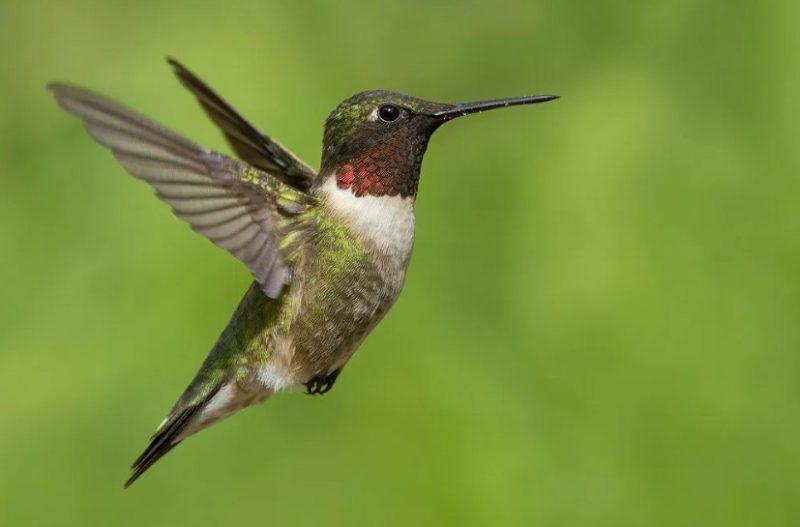
The Ruby-throated Hummingbird is a striking bird with a shimmering green back and a signature ruby-red throat in males. Found across eastern North America, it thrives in gardens, woodlands, and meadows. Known for its rapid wingbeats—up to 80 times per second—this tiny bird fuels itself by sipping nectar from flowers and feeders. Despite its small size, it fiercely defends feeding territories against intruders.
During migration, Ruby-throated Hummingbirds travel solo, flying nonstop across the Gulf of Mexico. Females craft delicate nests from plant fibers and spider silk, raising two chicks per brood. Conservation efforts, like planting native flowers, help sustain their populations.
Anna’s Hummingbird
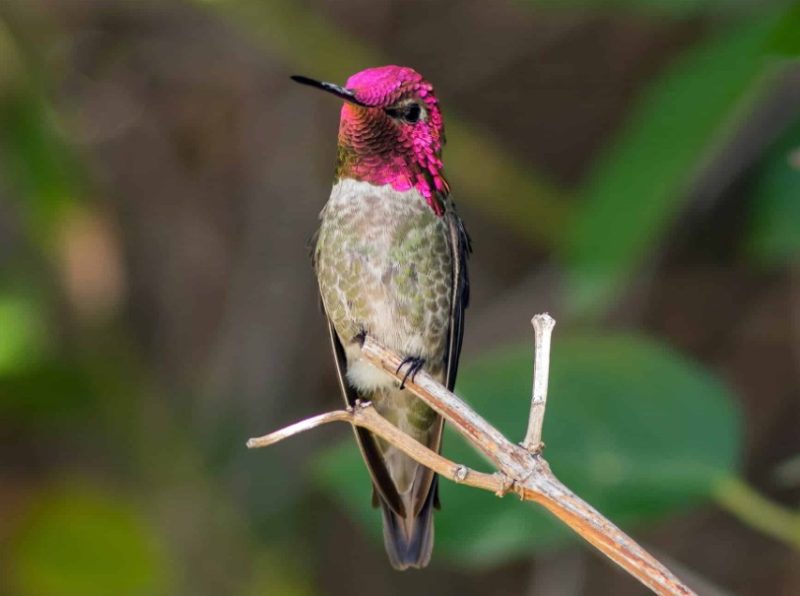
Anna’s Hummingbird is a year-round resident along the Pacific Coast, famous for its vibrant magenta crown and throat in males. Unlike many hummingbirds, it braves colder winters by entering torpor, slowing its metabolism to conserve energy. It primarily feeds on nectar but also consumes insects for protein.
This species thrives in urban parks, gardens, and coastal scrublands. Its buzzing, high-speed dives are part of an elaborate courtship display. Named after a 19th-century duchess, Anna’s Hummingbird continues to enchant birdwatchers with its resilience and striking colors.
Rufous Hummingbird
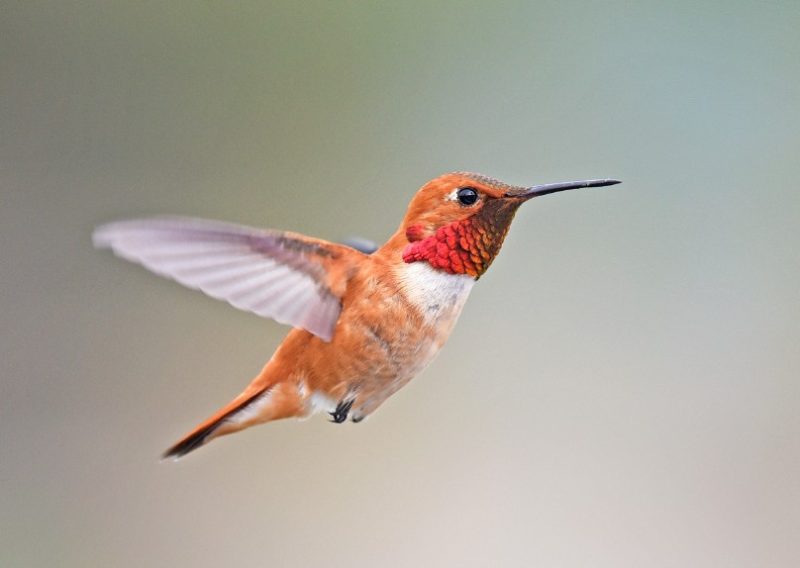
The Rufous Hummingbird is renowned for its fiery orange plumage and tenacious spirit. These birds undertake one of the longest migrations relative to their size, traveling from Alaska to Mexico. Males are bright coppery-orange, while females have green backs with rufous accents.
Highly territorial, Rufous Hummingbirds aggressively chase away intruders, even larger birds. They nest in forests, meadows, and gardens, favoring areas with abundant wildflowers. Their incredible endurance and adaptability make them one of the most remarkable hummingbird species.
Allen’s Hummingbird
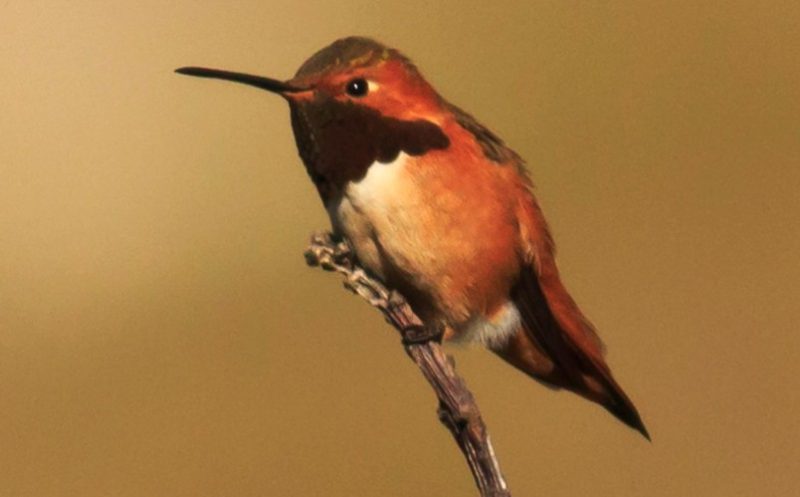
A coastal California native, Allen’s Hummingbird is a small but vibrant species with a fiery orange throat and green back. Unlike many migratory hummingbirds, it sticks to a narrow range, breeding in coastal areas before wintering in Mexico. It prefers meadows, gardens, and chaparral habitats.
Allen’s Hummingbirds are skilled at trap-lining, revisiting specific nectar sources throughout the day. They build tiny nests from soft plant material and spider silk, often reusing them. Though territorial, they sometimes tolerate other hummingbirds nearby.
Calliope Hummingbird
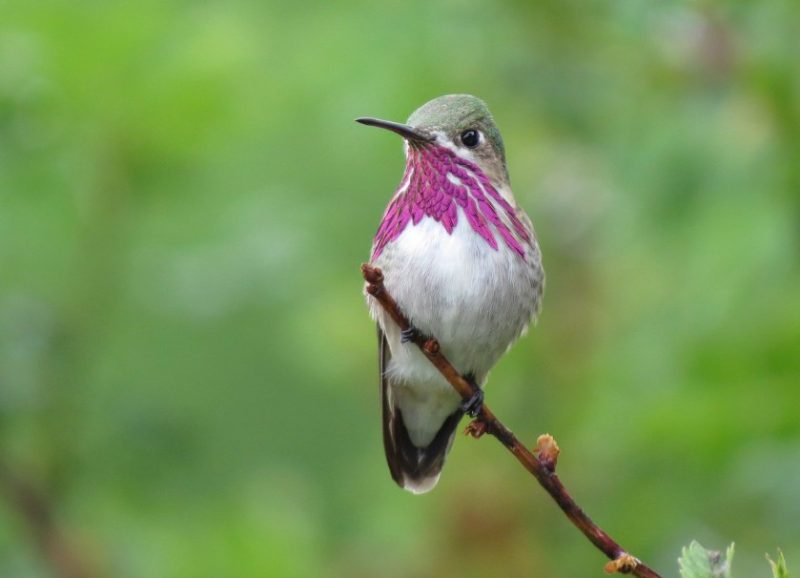
The Calliope Hummingbird holds the title of North America’s smallest breeding bird, weighing less than a penny. Males have striking magenta streaks on their throats, while females are more subdued with green backs and white underbellies.
This tiny traveler breeds in mountain meadows of the western U.S. and migrates to Mexico for winter. Calliope Hummingbirds feed on nectar and insects, often hovering at flowers too small for larger birds. Their size doesn’t hinder their incredible migratory feats, covering thousands of miles each year.
Broad-tailed Hummingbird
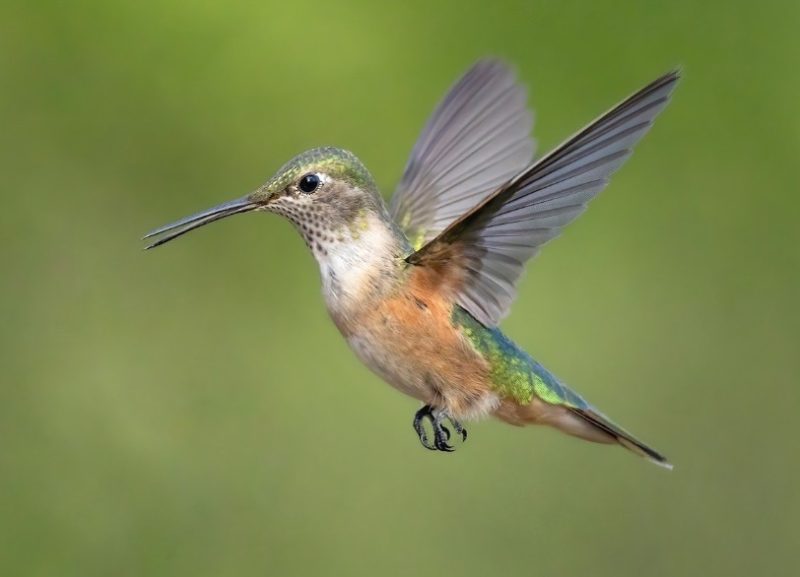
The Broad-tailed Hummingbird is a mountain specialist, breeding in the high-altitude meadows and forests of the western U.S. Males have a distinctive iridescent rose-pink throat and a broad, fan-like tail that produces a trilling sound in flight. Females are green-backed with pale underparts and white-tipped tail feathers.
This species prefers wildflower-rich areas near streams, feeding on nectar and small insects. In winter, it migrates to Mexico, favoring pine and oak woodlands. Gardeners can attract Broad-tailed Hummingbirds by planting red tubular flowers and providing feeders.
Costa’s Hummingbird
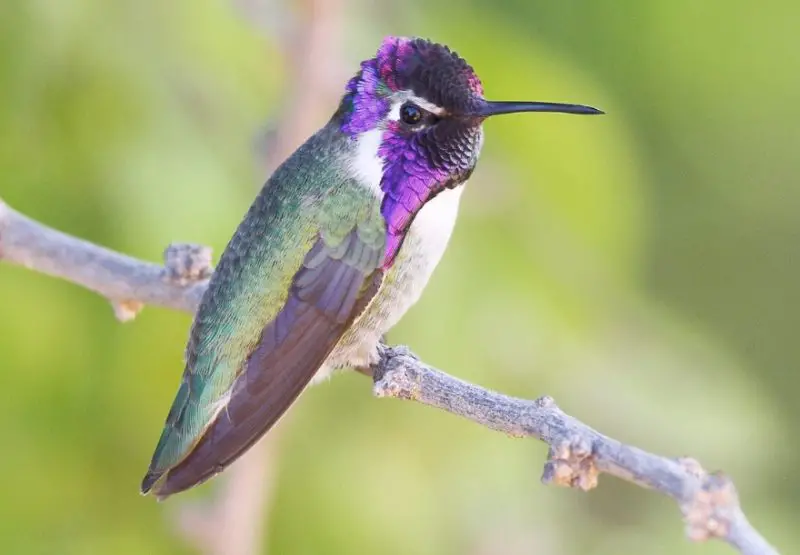
Costa’s Hummingbird is a desert dweller, thriving in the arid landscapes of the southwestern U.S. and northern Mexico. Males are striking with an iridescent violet crown and flared purple throat, while females are more muted with pale underparts and green backs.
Well-adapted to desert life, Costa’s Hummingbirds frequent cactus-filled habitats, dry washes, and scrublands. They feed on nectar from desert blooms like ocotillo, agave, and chuparosa, supplementing their diet with insects. Their small, cup-shaped nests are built in shaded branches, often near human dwellings.
Violet-crowned Hummingbird
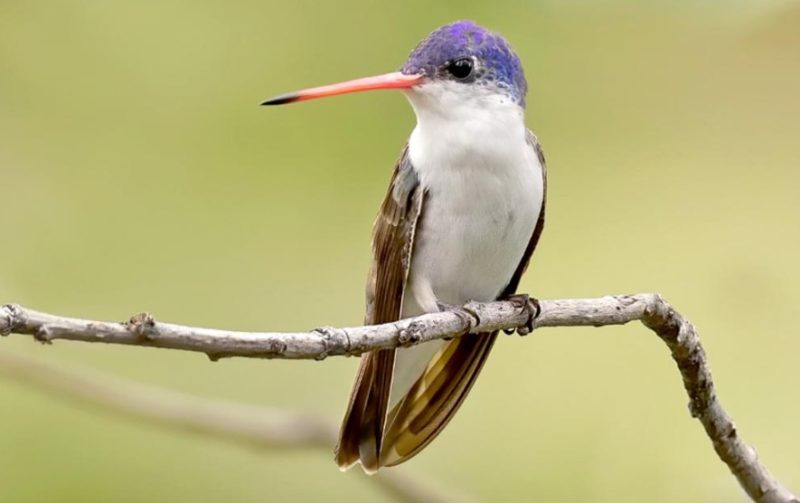
Named for its brilliant violet cap, the Violet-crowned Hummingbird is a striking species found in Mexico and parts of the southwestern U.S. Males have a bright green back, white underparts, and a red-orange bill, while females are duller with a subdued crown.
These hummingbirds prefer canyons, foothills, and riparian woodlands with sycamores and agaves. They feed on nectar from trumpet vine, coral bean, and fuchsia, also catching small insects mid-air. Their delicate nests are often placed near water sources, making them a rare but treasured sight in their northern range.
Black-chinned Hummingbird
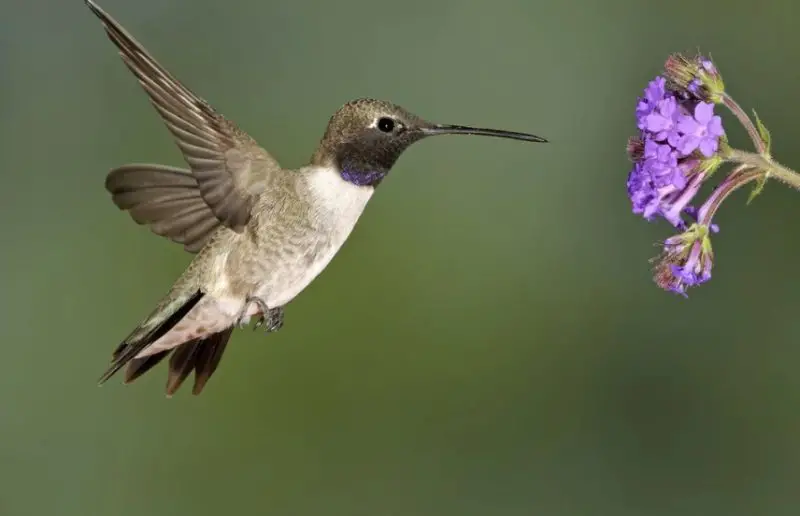
The Black-chinned Hummingbird is a widespread species in the western U.S., easily identified by the dark purple-black throat patch in males. Females lack the dark chin and have pale greyish underparts with green backs.
Adaptable and resilient, this hummingbird breeds in diverse habitats, from canyons and brushy areas to suburban gardens. It feeds on nectar from tubular flowers like Indian paintbrush and penstemon, using its extendible tongue to reach deep into blossoms. Males perform impressive aerial displays, diving in loops to impress potential mates.
Lucifer Hummingbird
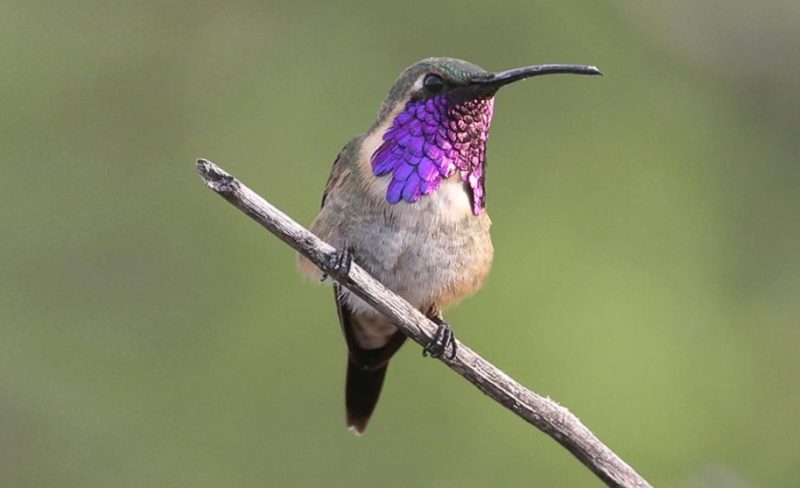
The Lucifer Hummingbird is a rare, jewel-toned species inhabiting the dry mountain slopes of northern Mexico. Males shimmer with gold-green plumage, a striking violet throat, and a curved bill, while females are more subdued in color.
These hummingbirds favor oak and pine-oak woodlands, often nesting in steep canyon slopes. They rely on nectar from morning glory, honeysuckle, and agave, contributing to pollination in their ecosystem. Their migration coincides with the monarch butterfly’s journey to Mexico, showcasing nature’s interconnected rhythms.
Berylline Hummingbird
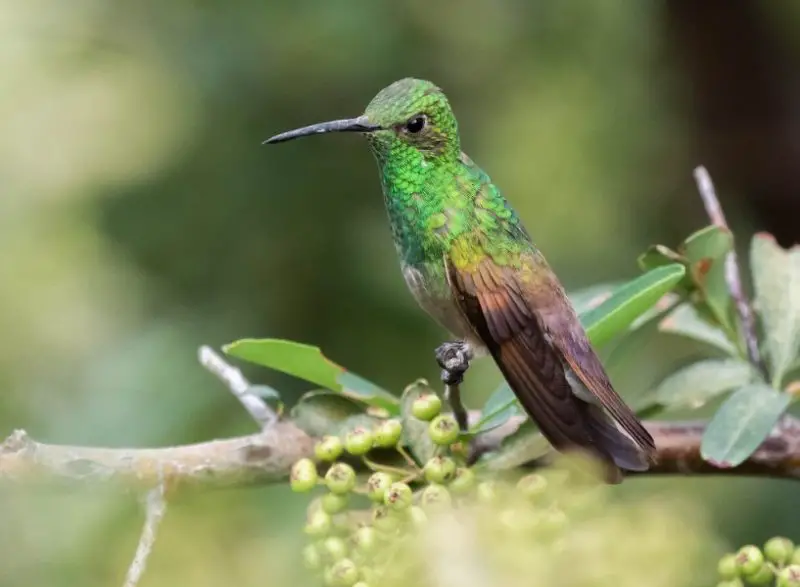
The Berylline Hummingbird is an elegant species found in Mexico and the southwestern U.S., known for its yellowish underparts and striking orange bill. Males have an iridescent green crown, bold white eye stripes, and grayish lower parts, while females are duller with a more muted face pattern.
Preferring pine-oak forests and mountain canyons, these hummingbirds rely on nectar from agaves and flowering shrubs. They also frequent hummingbird feeders. Nesting along forested streams, they build tiny cup nests from plant fibers. Habitat loss threatens their populations.
Buff-bellied Hummingbird
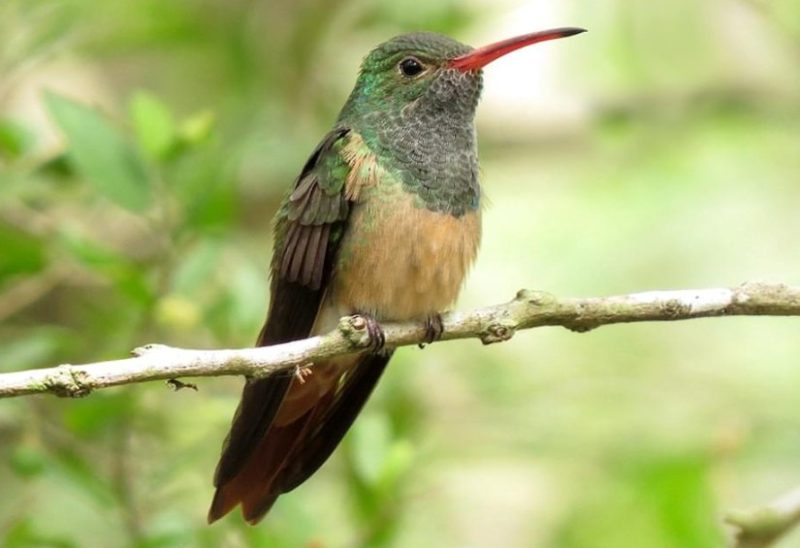
The Buff-bellied Hummingbird is a vibrant species native to Mexico and Guatemala, easily identified by its buff-colored underside. Males sport an iridescent turquoise-green throat, while females have speckled throats and metallic hints.
These territorial birds defend flowering trees and shrubs in forests, scrublands, and gardens. They consume nectar from century plants and Salvias, as well as small insects. Short-distance migrants, they move between breeding and wintering grounds. Deforestation poses a threat to their habitat.
White-eared Hummingbird
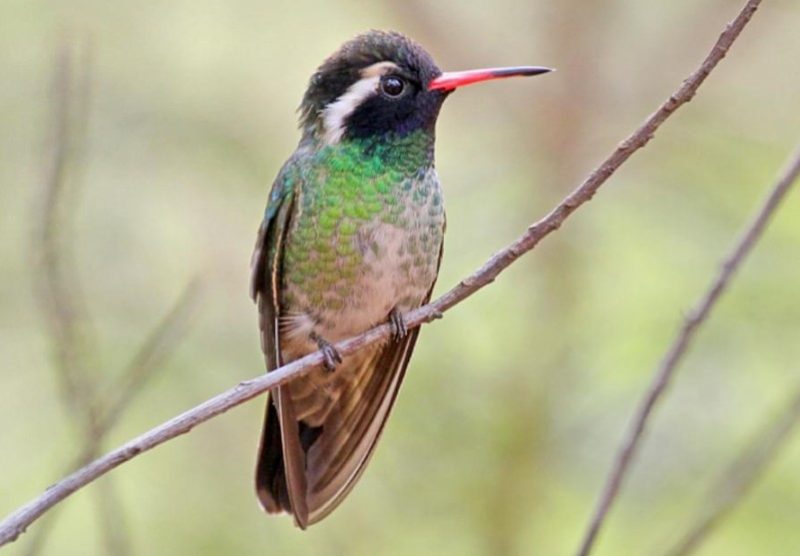
The White-eared Hummingbird is a striking species of Mexico and Central America’s pine-oak forests, known for its bold white ear tufts. Males display an emerald green body, a violet throat, and a red bill tipped in black. Females are paler with whitish undersides and green backs.
Aggressive defenders of nectar-rich plants, these birds feed on tubular flowers such as Esperanza and Salvias. They also migrate short distances within montane regions. Habitat loss is an increasing concern for this species.
Magnificent Hummingbird
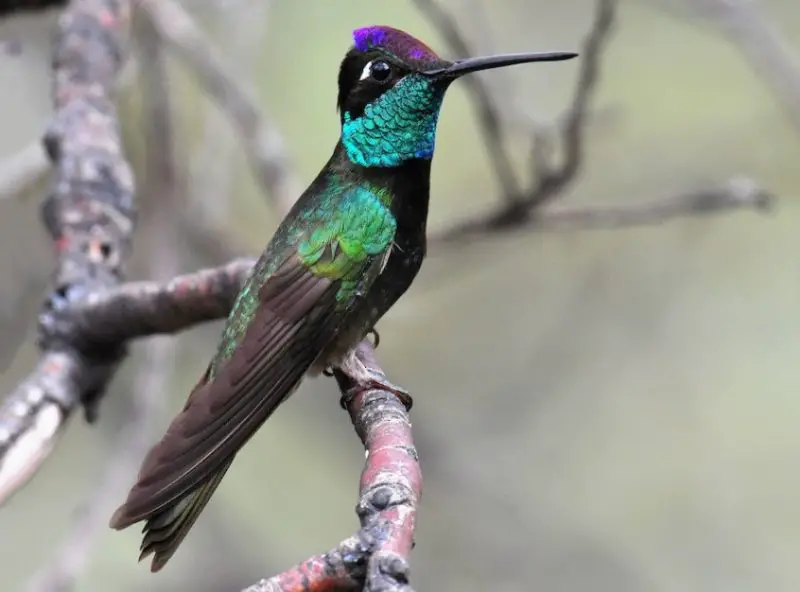
The Magnificent Hummingbird is one of North America’s largest hummingbirds, easily recognized by its iridescent rose-pink throat and crown. Males are dark green with long tails, while females have grey underparts and lack the vivid pink gorget.
Breeding in mountain forests and meadows, these hummingbirds migrate to Mexico’s coastal regions in winter. Known for their bold nature, they fiercely defend feeding territories. They favor red hot pokers, penstemons, and agaves for nectar and can reach speeds of 50 mph. Though common, habitat loss threatens their future.
Xantus’ Hummingbird
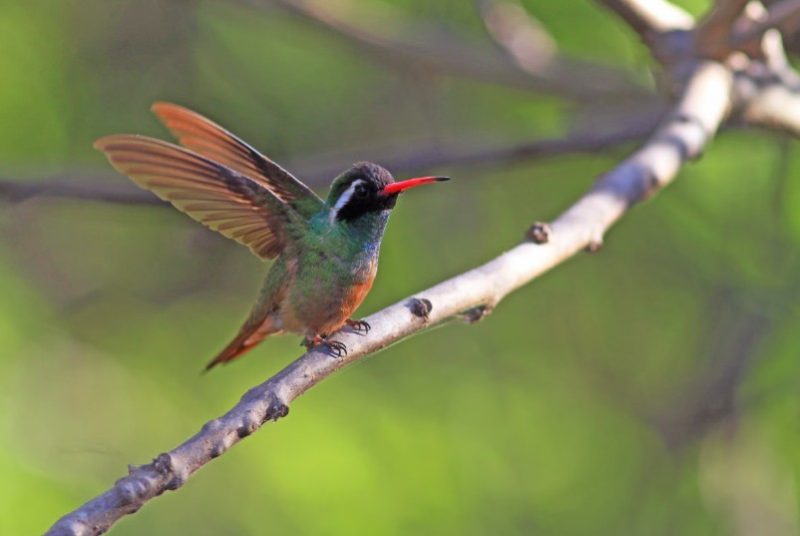
The Xantus’s Hummingbird is a small western species named after Hungarian zoologist John Xantus. Males have an iridescent purple-green throat and crown, a white breast band, and green flanks. Females lack the bright throat patch and are more grayish-white underneath with green backs.
This species breeds in the arid scrublands of the Baja California Peninsula and winters on the Mexican mainland. It thrives in dry washes, desert scrub, and oases filled with agaves and ocotillos. Xantus’s hummingbirds produce a quick, chipping call and defend territories around nectar-rich plants like Fairy Duster and Desert Lavender.
Long-billed Starthroat
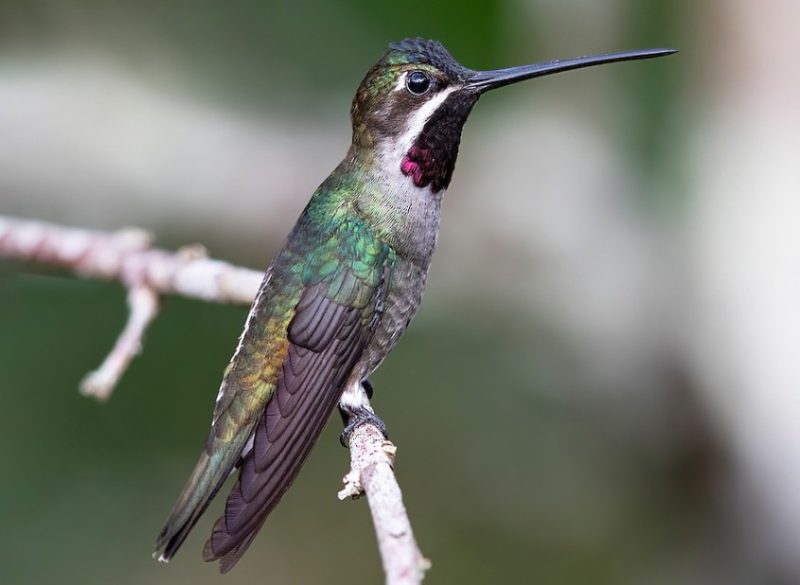
The Long-billed Starthroat is a large hummingbird with an exceptionally long, straight bill, found from Mexico to Costa Rica. Males have a violet throat bordered by iridescent blue ear patches, a straight bill, and a plain crown, while females are more olive green above and lack the bright throat patch.
Preferring lower mountain slopes and open woodlands, these hummingbirds feed on nectar from tubular flowers like Calliandra and orchids. Males perform aerial displays, flying up to 130 feet while producing a sharp staccato “chip” call. Though common, habitat loss could impact their populations.
Plain-capped Starthroat
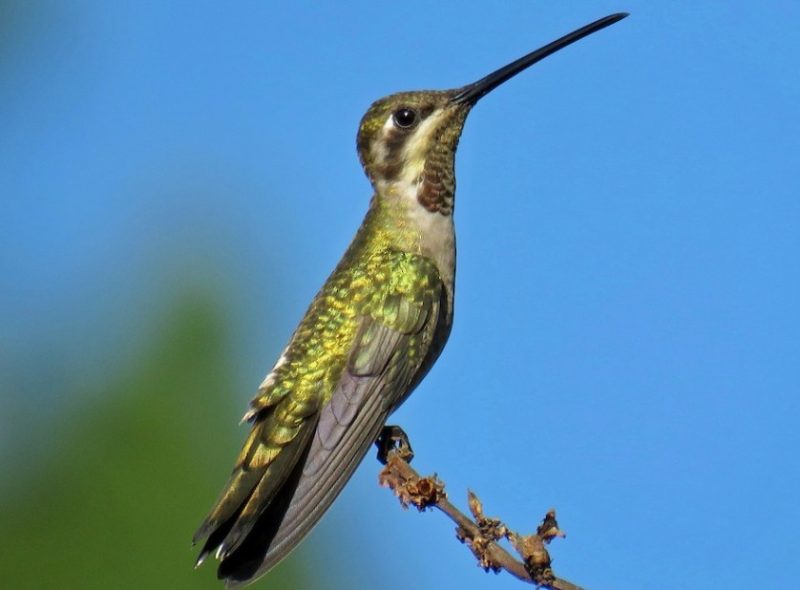
The Plain-capped Starthroat is a medium-sized hummingbird with a long, straight bill and streamlined shape, ranging from Mexico to Costa Rica. Males have a glittering violet-blue throat patch and crown, a white breast, and a plain cap, while females lack the bright throat patch.
They inhabit tropical deciduous forests, forest edges, and gardens, feeding on nectar from plants such as firecracker plants and coral vines. Their sharp “chip” call is used for territory defense. These birds build small cup nests overhanging streams and remain common, though habitat loss is a concern.
White-bellied Emerald
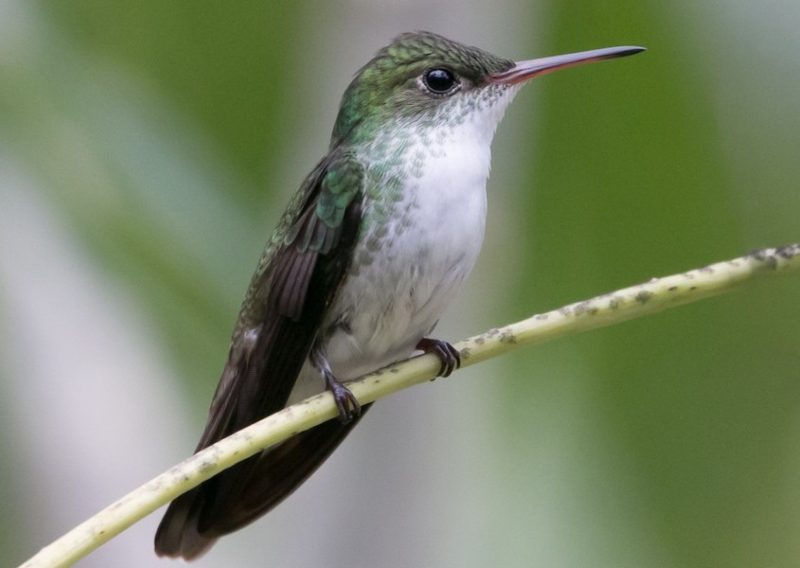
The White-bellied Emerald is a vibrant hummingbird with a bright red bill and a distinct whistling call. Native to tropical forests in Central and South America, it thrives in forest edges, second-growth scrub, and gardens.
Males have brilliant green upperparts and white underparts, while females have shorter, all-black bills. They sip nectar from flowers like Heliconia and ginger plants and build lichen-covered nests near streams. Though still widespread, habitat loss threatens some populations.
Green-breasted Mango
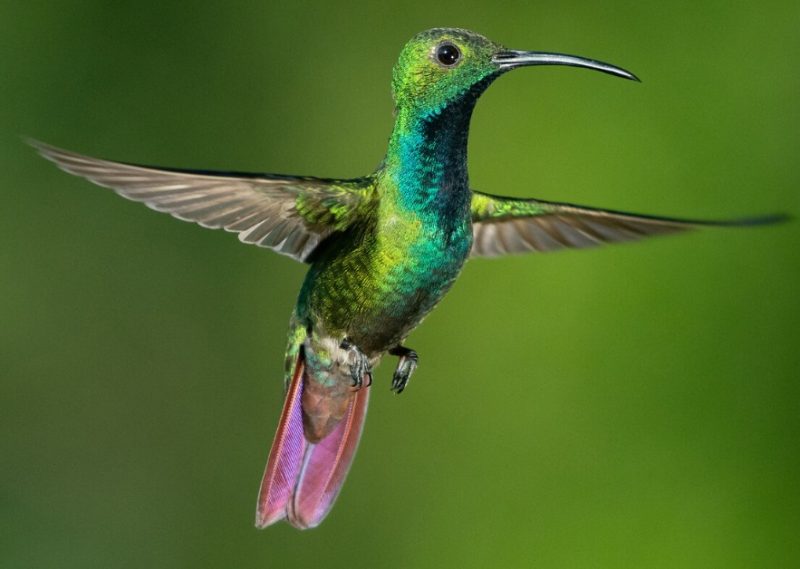
The Green-breasted Mango is an exotic-looking hummingbird with a glossy green breast and a striking purple crown. Males have a black-masked face and a deeply forked purple-black tail, while females share similar features but with less intense coloring.
Found in tropical forests and second-growth areas from Mexico to South America, these hummingbirds feed on nectar from deep corolla flowers like Heliconia. They aggressively defend feeding territories and perform dramatic courtship flights. Although common, habitat destruction poses a threat to this stunning species.
Amethyst-throated Hummingbird
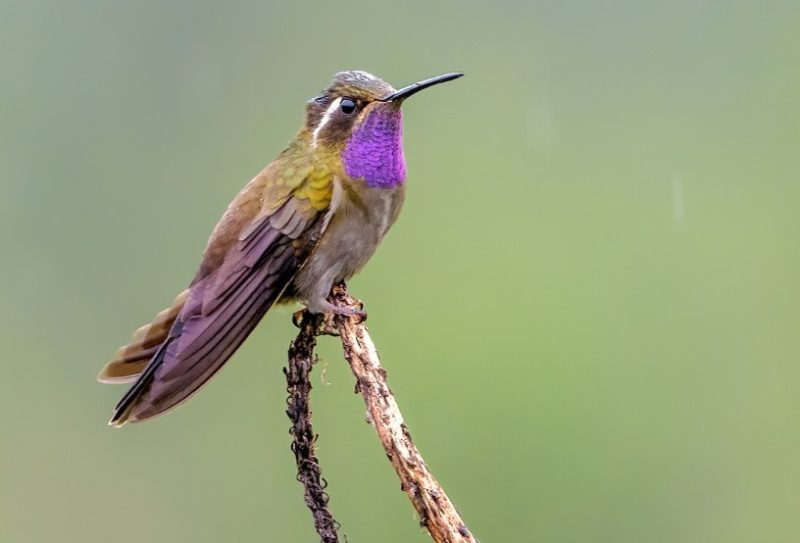
The Amethyst-throated Hummingbird is a dazzling jewel of the forests in Costa Rica and western Panama. Males boast a shimmering amethyst-purple throat and crown, contrasted with black ear patches and an iridescent green back. Females, in contrast, have greener plumage with pale underparts. This species faces severe threats from habitat destruction and illegal capture for the pet trade.
Preferring the dense canopy of lowland rainforests, these hummingbirds rarely descend to ground level. They rely on epiphyte flowers and nectar-rich trees for sustenance. While some populations persist in protected reserves, illegal trapping remains a concern, contributing to their continued decline.
Bahama Woodstar
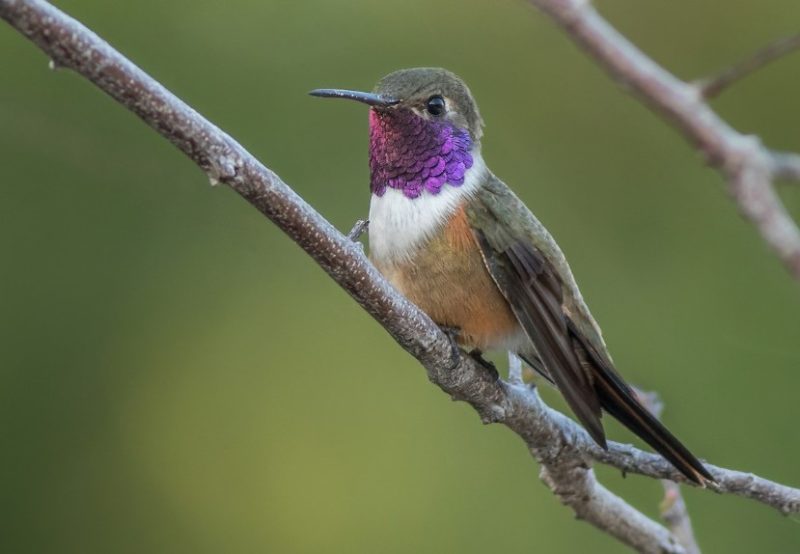
The Bahama Woodstar is a miniature hummingbird endemic to the Bahama Islands. Measuring just 2.5 inches, it is the smallest breeding bird in the region. Males feature a long, straight bill, an iridescent violet-blue crown and throat, and a short, forked tail with white underparts. Females are more subdued, with white-tipped outer tail feathers.
These birds thrive in pine woodlands, mangroves, and gardens, feeding on nectar from tubular flowers like Firebush, Turk’s Cap Cactus, and Brazilian Pepper. Despite their tiny size, they fiercely defend their feeding areas, emitting high-pitched twittering calls. Habitat loss due to development and storms threatens their survival.
Sapphire-spangled Emerald
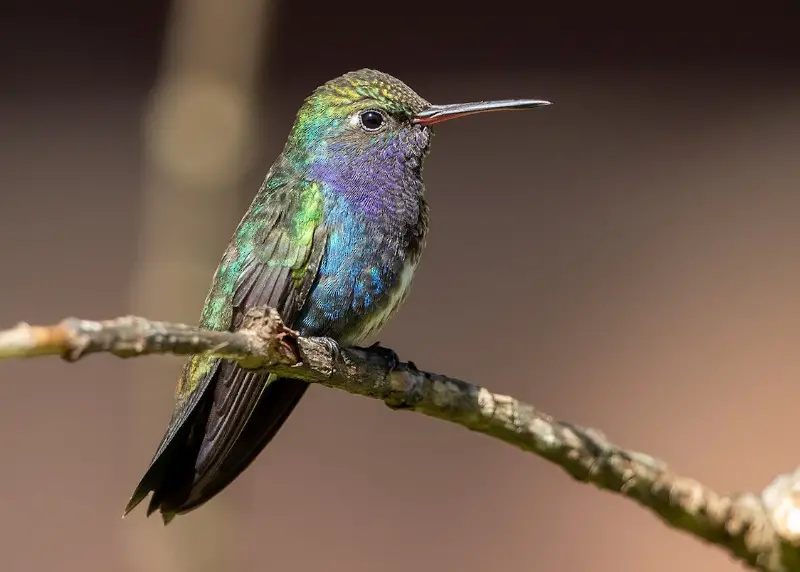
The Sapphire-spangled Emerald is a vibrant blue-green hummingbird found along the Caribbean coasts of Central America. Males display brilliant turquoise upperparts, white undersides, and blue-tipped tail feathers. Females are a more muted green with white tail feather tips.
This species inhabits coastal scrub, mangrove edges, and gardens, where it feeds on nectar from flowers such as Firecracker plants and Coral Vine. The male’s iridescent plumage produces a striking sapphire and emerald flash in flight. With a limited range, habitat destruction from tourism and coastal development threatens this species.
White-eared Hummingbird
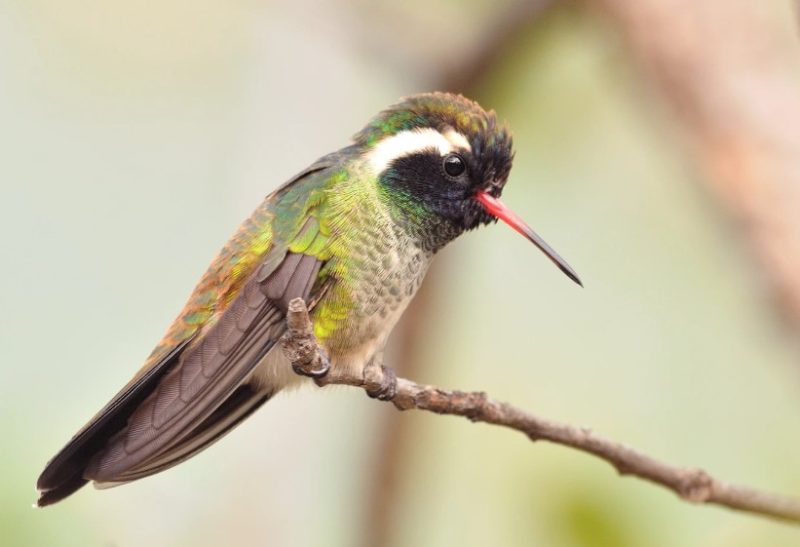
The White-eared Hummingbird thrives in high-altitude tropical forests. Rarely breeding in the U.S., males weigh around 3.6 grams, while females average 3.2 grams.
Males exhibit a purplish crown, blue-green chin, and a distinctive white ear stripe, along with a red bill with a black tip. Females have a green back and crown, white underparts streaked with green, and a similar ear stripe. Their preferred habitats include pine-oak woodlands and montane forests, where they feed on nectar and insects.
Green Violet-ear
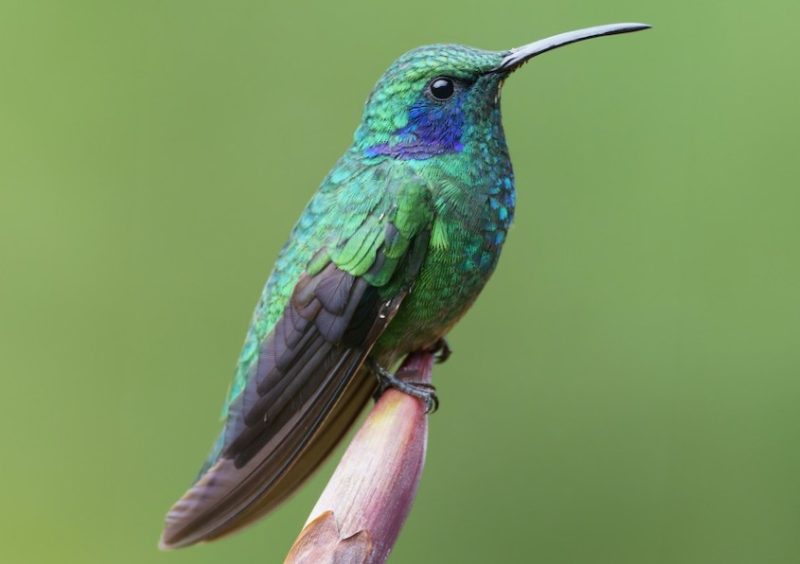
The Green Violet-ear is a striking hummingbird with vibrant green plumage and distinctive violet ear patches. Males shimmer with blue-violet throats and ear patches, while females have a duller green coloration with grayish underparts. These birds are found in tropical lowland rainforests and forest edges from Mexico to Panama.
Green Violet-ears prefer the canopy, feeding on nectar from epiphytes and other high-growing flowers. Unlike many hummingbirds, they cling vertically to flower clusters while feeding. Their seasonal elevational migrations follow blooming cycles, but deforestation threatens their habitat.
Long-billed Hermit
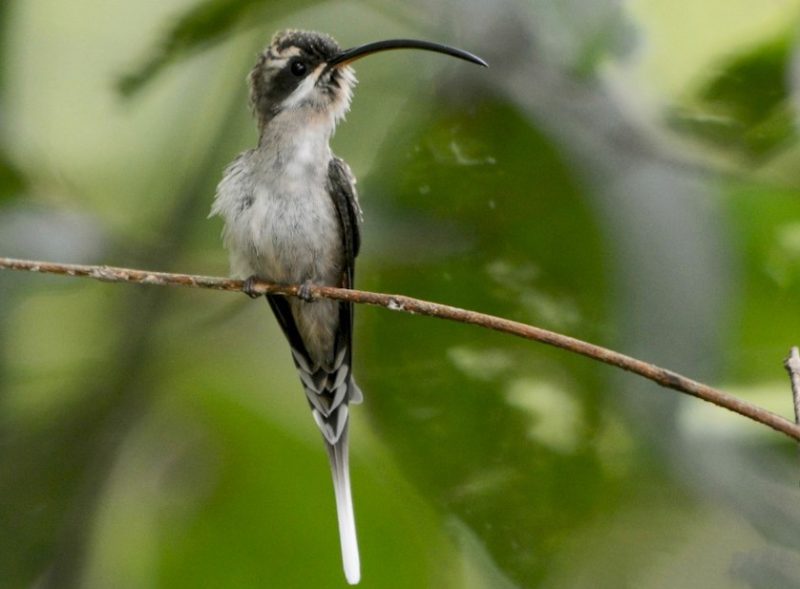
The Long-billed Hermit is a unique hummingbird recognized by its exceptionally long, slightly curved bill. Found from Mexico to Bolivia, this forest-dwelling species has velvety green upperparts, a blue-violet patch below the eye in males, and buffy underparts in females.
Their specialized bills allow them to extract nectar from deep, tubular flowers like passionflowers and leret blossoms. They cling to flowers while feeding using their curved claws. Preferring the dark forest understory, these solitary birds are at risk due to deforestation.
Saw-billed Hermit
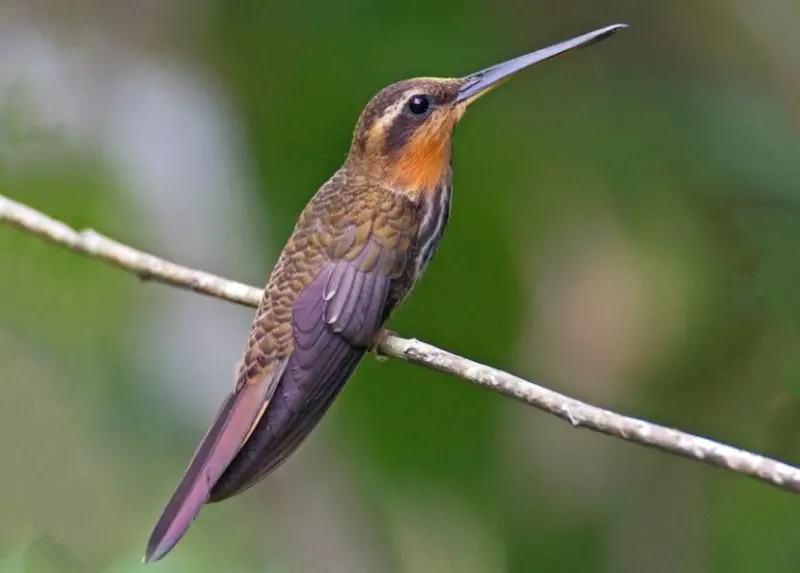
The Saw-billed Hermit is a rare Central American hummingbird distinguished by the serrated edges of its bill. Males have a bright red-orange bill, while females have a strongly hooked black bill. This species inhabits subtropical evergreen forests and mountain oak groves in Costa Rica and Panama.
Using their specialized bills, saw-billed hermits pry open the base of long tubular flowers like Heliconia to access nectar. They also supplement their diet with small insects. Little is known about their breeding habits, but habitat loss continues to threaten their limited range. The species is classified as Near Threatened due to its declining population.




